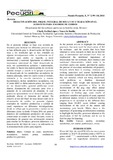Mostrar el registro sencillo del ítem
Desactivación del frijol integral de soya y su utilización en el alimento para engorde de cerdos
| dc.rights.license | http://creativecommons.org/licenses/by-nc-sa/3.0/ve/ | |
| dc.contributor.author | Farfán López, Charly | |
| dc.contributor.author | De Basilio, Vasco | |
| dc.date.accessioned | 2015-07-29T19:50:52Z | |
| dc.date.available | 2015-07-29T19:50:52Z | |
| dc.date.issued | 2014-12 | |
| dc.identifier.issn | 2343-6174 | |
| dc.identifier.uri | http://www.saber.ula.ve/handle/123456789/40754 | |
| dc.description.abstract | En el presente trabajo se hace una revisión de literatura para destacar los diferentes procesos que se han utilizado para la desactivación del frijol de soya y los resultados que se han obtenido en algunas investigaciones sobre su utilización en el alimento para cerdos de engorde, a nivel internacional y nacional. Igualmente se enfatiza la importancia nutricional del frijol desactivado de soya, sus características químicas y nutricionales, las cuales la hacen una materia prima de excelente calidad, siempre y cuando se le aplique el proceso de desactivado de los metabolitos secundarios de manera adecuada, entre los cuales existe el tostado, extrusión y la cocción (autoclave y reactor hidrotérmico), dichos metabolitos secundarios, son el punto débil de dicha materia prima, los cuales al no ser desactivados, generan problemas como diarrea, disminución del consumo, peso vivo y aumento de la conversión de alimento, lo cual genera un aplazamiento en el desarrollo del cerdo, pudiendo afectar el bienestar del animal. En relación al uso del frijol de soya desactivado en la alimentación de cerdos, se presenta algunos resultados de variables productivas y calidad de canal, reportados en diferentes investigaciones, donde se refleja que la proporción a incluir en las diferentes dietas va desde 10 hasta 26% sin generar deterioro del rendimiento productivo del animal y conservando su estado de salud. En tanto, existe la importancia de generar una información resumen para resaltar las bondades, procesos inherentes a la desactivación del frijol de soya y su utilización en la alimentación de cerdos para engorde. | es_VE |
| dc.language.iso | es | es_VE |
| dc.rights | info:eu-repo/semantics/openAccess | |
| dc.subject | Calidad de canal | es_VE |
| dc.subject | metabolitos secundarios | es_VE |
| dc.subject | materia prima | es_VE |
| dc.subject | rendimiento productivo | es_VE |
| dc.subject | porcinos | es_VE |
| dc.title | Desactivación del frijol integral de soya y su utilización en el alimento para engorde de cerdos | es_VE |
| dc.title.alternative | Deactivation full fat soybeans and its use in food for swine. Review | es_VE |
| dc.type | info:eu-repo/semantics/article | |
| dc.description.abstract1 | In the present review to highlight the different processes that were used for deactivation of full fat soybeans and the results that have been obtained in some research on their use in feed for pigs, at international and national level. Also are emphasized the nutritional importance of deactivation full fat soybeans, their chemical and nutritional characteristics, which make it an excellent quality raw matter, provided he applies the process of secondary metabolites off properly, between which there is roasting, extrusion and cooking (autoclave and reactor hydrothermal), these secondary metabolites are the weak point of this raw material, which not being deactivated, such problems as diarrhea, decreased consumption, body weight and increased feed conversion, which generates a delay in the development of the pig, may affect animal welfare. In relation the use of full fat soybeans deactivated in feeding pigs, some results of productive variables and quality of canal, reported in different studies, where it is reflected that the proportion to be included in the different diets ranging from 10-26% occur without causing deterioration of the yield of the animal and maintaining your health. While, there is the importance of generating an information summary to highlight the benefits, processes inherent to the deactivation of full fat soybeans and its use in feed for pigs for fattening. | es_VE |
| dc.description.colacion | 99-110 | es_VE |
| dc.description.email | charly.farfan@gmail.com | es_VE |
| dc.identifier.depositolegal | PPI 200502ME4431 | |
| dc.publisher.pais | Venezuela | es_VE |
| dc.subject.facultad | Núcleo Rafael Rangel (NURR) | es_VE |
| dc.subject.institucion | Universidad de Los Andes | es_VE |
| dc.subject.keywords | Carcass quality | es_VE |
| dc.subject.keywords | secondary metabolites | es_VE |
| dc.subject.keywords | raw matter | es_VE |
| dc.subject.keywords | performance | es_VE |
| dc.subject.keywords | swine | es_VE |
| dc.subject.publicacionelectronica | Revista Mundo Pecuario | |
| dc.subject.seccion | Revista Mundo Pecuario: Revisión | es_VE |
| dc.subject.tipo | Revistas | es_VE |
| dc.type.media | Texto | es_VE |
Ficheros en el ítem
Este ítem aparece en la(s) siguiente(s) colección(ones)
-
Mundo Pecuario - Vol. 010 - Nº 3
Septiembre - Diciembre 2014


